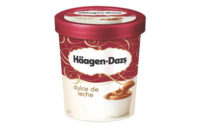Learning Latin
With consumers expecting new flavors that broaden their culinary horizons, many manufacturers need only look south, though admittedly fairly far south -- to the spicy and sweet cuisines of Latin America and the Caribbean.


“Authentic flavors made especially for your baby” is the marketing angle for a joint baby food launch from Goya Foods and Beech-Nut.

PepsiCo’s Frito-Lay has partnered with Tapatio for a range of snack foods with the signature hot sauce, including Cheetos Tapatio and Lay’s Tapatio.

The Latin/Caribbean influence is far from limited to the U.S., as the UK has seen such launches as McCain Foods’ Caribbean Wedges, potatoes with such flavorful spices as red chili pepper and coriander.






Clearly, Latin and Caribbean cuisine is not solely tailored for U.S. Hispanics. The popularity of these flavors and influences crosses many borders and demographics; however, the growth of the Hispanic population in the U.S. cannot be undervalued in explaining at least some of the rise in popularity of these flavors. It is, after all, the fastest growing consumer group in the nation.
The U.S. Census Bureau notes there are more than 52 million Hispanics in the country. This number is expected to reach 132.8 million by 2050, representing more than 30% of the entire U.S. population. Economically, this group already has tremendous influence. U.S. Hispanics had an estimated $1.2 trillion in purchasing power in 2012, and it is expected to surpass $1.5 trillion by 2015.
The influence of these flavor profiles can even be found in poultry preferences, explains Bill Lovette, chief executive of Pilgrim’s Pride, at the Chicken Media Summit. “Demographics are changing. There is a growing population that prefers dark meat.”
Mintel research finds sales of ethnic foods overall rose 4.5%, to reach $8.7 billion, between 2010-2012. Furthermore, the group expects sales of ethnic foods in grocery stores will grow more than 20% through 2017. Admittedly, those sales figures are for the rather broadly defined “ethnic foods” as a whole (indeed, the group forecasts the most growth in Mediterranean and Middle Eastern foods), but it does indicate a growing interest among all consumers in new and diverse flavors.
For that matter, the wave of such Latin American-inspired flavors and options is by no means confined to American shelves. In the UK, McCain Foods introduced a limited edition of Caribbean Wedges, potatoes seasoned with spices and “Caribbean attitude.” While the ingredients imparting the “attitude” might be tough to quantify, the spices include ginger, red chili pepper, coriander, cinnamon, clove and paprika extract.
Being Sweet
Stateside, numerous products are seeing slight -- or even rather pronounced -- tweaks to their formulations to broaden their appeal and add a Latin inspiration. Over the summer, Nestlé introduced a dulce de leche Cheesecake Kit incorporating the company’s La Lechera sweetened, condensed milk. Each kit includes the condensed milk, a crust mix and a filling mix, with the consumer left to add butter, eggs and cream cheese. The line also has a Mexican Style Chocolate Cheesecake Kit featuring the same ingredients, but adding Nestle’s Abuelita Mexican-style Chocolate. Abuelita is something of a staple in Hispanic kitchens, used for cooking and for hot beverages.
“The acculturation of those communities into the mainstream has made American consumers generally more open to new tastes and textures,” notes Carlos Velasco, president of the international brands division of Nestlé USA, in a recent New York Times interview. “The good challenge for companies like Nestlé is getting an understanding of those trends and then translating them for this market, because you cannot always use the exact recipes and language that is used in other markets.”
Hot Forecast
Frequently for manufacturers, appealing to the curious consumer or even the dedicated lover of Latin cuisine is more a matter of turning up the heat in an established brand. With a number of its Frito-Lay snacks, PepsiCo has partnered with Tapatio to add a hot flavor to its products, including Lay’s Tapatio Limon-flavored potato chips and Cheetos Tapatio-flavored snacks, which joined Ruffles Tapatio Limon-flavored potato chips and Doritos Tapatio earlier this year. Available in Western and Central regions of the U.S., the products draw upon the surge in growth of the hot sauce category, which PepsiCo notes has seen sales grow 150% over the past decade. Lay’s Tapatio Limon and Cheetos Tapatio promise a “unique combination” of red chili peppers, spices and a hint of garlic: the same ingredients used in creating the original Tapatio hot sauce. Lay’s Tapatio merges those flavors with lime juice for a spicy, tangy twist.
Such a blending of flavors is more or less a reflection of consumer usage anyway, say Frito-Lay developers.
“We know that many of our consumers are already pairing their favorite hot sauce with their favorite snacks,” explains Ram Krishnan, vice president of marketing with Frito-Lay North America.
Aiming for Authentic
Nevertheless, there is a growing audience for whom “spicy” does not necessarily equate with “authentic.” For that group, Herdez -- probably best known for its salsa brand -- introduced a line of Mexican Cooking Sauces to incorporate into “authentic and sophisticated Mexican cuisine.” At the same time, the line adds another on-trend benefit to the authentically ethnic flavor profile: convenience.
A Herdez survey found home cooks are seeking shortcuts when preparing homemade meals, and the line of cooking sauces allows consumers to add protein and simmer for 7-10 minutes for a quick meal; or to utilize them as an ingredient in more complex dishes. Herdez’ survey also suggests consumer attitudes toward convenience might have as much to do with cooking confidence as with quickly prepared.
A company release notes, “Respondents of the survey also expressed that a product like this would encourage them to cook Mexican dishes at home more frequently and to try new flavors they may not have tried.”
The Herdez Mexican Cooking Sauce varieties include Traditional Chipotle, Roasted Pasilla Chile, Red Guajillo Chile and Tomatillo Verde, and those options were chosen at launch for a specific reason.
“The four flavors we chose for the launch of the Herdez Mexican Cooking Sauces are foundational within authentic Mexican cooking. The sauces do not compromise on the delivery of real, authentic flavor, yet allow consumers to forego the time, effort and know-how associated with making these sauces from scratch,” explains Gilberto Gutierrez, brand manager with Herdez Brand & Import Foods.
Gutierrez says the authenticity of the sauces is a result of the rich, fragrant flavors of chile peppers used as the base; these peppers are not utilized so much for their heat as for the flavor they impart overall. In fact, he notes the line is focused more on flavor than on spicy: Traditional Chipotle promises a warm, smoky flavor and a sweet tang from tomato, onion and vinegar, while the mild heat of the Pasilla Chile blends with tomatoes, onions and garlic in the Roasted Pasilla Chile Sauce.
While Herdez merged the convenience trend into the area of ethnic foods, another manufacturer has blended convenience and allergen-free concepts into a quick take on a popular Hispanic dish. Evol now offers dairy-free Gluten Free Burritos, made with a whole-grain, gluten-free tortilla and available in Gluten Free Chicken, Gluten Free Shredded Beef and Gluten Free Chicken Plus options (the “Plus” variety adding guacamole). All promise to be “stuffed with an authentic tomato and roasted corn salsa,” as well as premium flavors and spices.
The company also is increasing its sourcing of organic ingredients, assuring that 25% of its total raw goods will be organic in 2013. Bean & Cheddar Burritos and Cilantro Lime Chicken Burritos are now made with 80 and 70% organic ingredients, respectively.
“We’re very excited about the introduction of these new products and the re-launch of our Classic Burrito product line,” explains Evol COO and founder Phil Anson. “We believe our increased focus on organic ingredients and enhanced nutritional label is well aligned with what consumers want in their food, as well as Evol’s mission, vision and values.”
Yielding to Youth
Goya Foods has focused on new packaging for its Goya Marinades line, which includes such varieties as Mojo Chipotle, Naranja Agria, Mojo Picante and Mojo Criollo. The packaging design seeks “to highlight the unique flavors and use of each product…The brand’s Latin American heritage is celebrated in the design and quirky typeface,” a company release explains, but a recent partnership with another established brand may prove an even bolder move.
Goya and Beech-Nut earlier this year launched a co-branded line of baby food, Beech-Nut Goya, which is promoted as “authentic Hispanic flavors made especially for your baby.”
“Our research shows that Hispanic moms have been waiting for just such an offering, which combines the authentic, traditional Latin flavors Goya is famous for with Beech-Nut’s nutritious, natural ingredients free of preservatives,” says Beech-Nut president Jeff Boutelle. “Our products are as close as possible to homemade, and that’s very important to Hispanic families.”
“The Beech-Nut/Goya line of baby food offers mom the best of both worlds,” adds Bob Unanue, president of Goya Foods. “Hispanic moms, influenced by their abuelitas, oftentimes believe that healthy, traditional baby food can only be made at home using fresh ingredients. Their challenge is that they simply don’t have the time to cook from scratch the way their grandmothers did...Our new line of baby food is the perfect union that bridges Hispanic mothers’ desire for healthy, traditional baby food with their need for convenience and nutrition in today’s hectic world.”
“One fourth of all births in America today are to Hispanics, so any company hoping to grow their business must take their needs and tastes into account,” explains Boutelle. “Because Hispanic families are also larger than non-Hispanic families, their purchase of baby food is 15% higher than for other demographics.”
A Beech-Nut study found two thirds of Hispanic moms were not satisfied with the choices they presently find in baby food and wished there were more culturally traditional flavors from which to choose. The new Beech-Nut Goya brand offers 22 Latino flavors.
Certainly, whether due to the growing number of Hispanic consumers or simply the surge in popularity of these flavors, the growth and increased diversity of these cuisines is expected to continue in the foreseeable future.
In fact, per Technomic’s 2013 restaurant trend predictions, “Just as diners who love Asian fare have explored beyond Chinese to develop a taste for Thai and Vietnamese, those who favor Mexican are now looking south -- to Brazil, Argentina and Peru.”
The foodservice market research group expects the country will experience a mainstreaming of South American-style grilled meats, chimichurri sauce, ceviche, South American-Asian fusion seafood dishes and iconic drinks -- from Brazil’s caipirinha to Peru’s pisco sour.
Looking for a reprint of this article?
From high-res PDFs to custom plaques, order your copy today!










